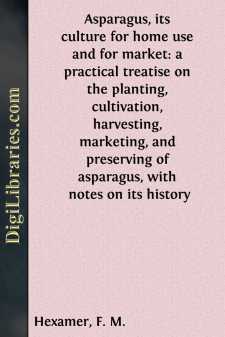Categories
- Antiques & Collectibles 13
- Architecture 36
- Art 48
- Bibles 22
- Biography & Autobiography 813
- Body, Mind & Spirit 142
- Business & Economics 28
- Children's Books 15
- Children's Fiction 12
- Computers 4
- Cooking 94
- Crafts & Hobbies 4
- Drama 346
- Education 46
- Family & Relationships 57
- Fiction 11828
- Games 19
- Gardening 17
- Health & Fitness 34
- History 1377
- House & Home 1
- Humor 147
- Juvenile Fiction 1873
- Juvenile Nonfiction 202
- Language Arts & Disciplines 88
- Law 16
- Literary Collections 686
- Literary Criticism 179
- Mathematics 13
- Medical 41
- Music 40
- Nature 179
- Non-Classifiable 1768
- Performing Arts 7
- Periodicals 1453
- Philosophy 64
- Photography 2
- Poetry 896
- Political Science 203
- Psychology 42
- Reference 154
- Religion 513
- Science 126
- Self-Help 84
- Social Science 81
- Sports & Recreation 34
- Study Aids 3
- Technology & Engineering 59
- Transportation 23
- Travel 463
- True Crime 29
Asparagus, its culture for home use and for market: a practical treatise on the planting, cultivation, harvesting, marketing, and preserving of asparagus, with notes on its history
by: F. M. Hexamer
Description:
Excerpt
PREFACE
he cultivation of asparagus for home use as well as for market is so rapidly increasing, and reliable information pertaining to it is so frequently asked for, that a book on this subject is evidently needed. While all works on vegetable culture treat more or less extensively on its cultivation, so far there has been no book exclusively devoted to asparagus published in America. Asparagus is one of the earliest, most delicious, and surest products of the garden. Its position among other vegetables is unique, and when once planted it lasts a lifetime; it may be prepared for use in great variety, and may be canned or dried so as to be available at any time of the year; and yet in the great majority of farm gardens it is almost unknown. The principal reason for this neglect is based upon the erroneous idea that asparagus culture requires unusual skill, expense, and hard work. While this was true, in a measure, under old-time rules, modern methods have so simplified every detail connected with the cultivation of asparagus as to make it not necessarily more expensive and laborious than that of any other garden crop. To describe and make clear these improved methods, to demonstrate how easily and inexpensively an asparagus bed may be had in every garden, and how much pleasure, health, and profit may be derived from the crop have been the principal inducements to writing this book.
In a popular treatise on so widely distributed a vegetable as asparagus, the cultivation of which had been brought to a high state of development many centuries before the Christian era, there is little opportunity for originality. All that the author has endeavored in this little volume has been to collect, arrange, classify, and systematize all obtainable facts, compare them with his own many years' experience in asparagus culture, and present his inferences in a plain and popular manner. Free use has been made of all available literature, especially helpful among which has been the Farmers' Bulletin No. 61 of the United States Department of Agriculture, by R. B. Handy; also bulletins of the Missouri, New York, Ohio, New Jersey, North Carolina, Maryland, Massachusetts, and South Carolina and other experiment stations; the files of American Agriculturist; Gardener's Chronicle, from which descriptions of several ornamental species by William Watson were condensed; Thome's "Flora von Deutschland;" "Eintraegliche Spargelzucht," von Franz Goeschke; "Braunschweiger Spargelbuch," von Dr. Ed. Brinckmeier; "Parks and Gardens of Paris," by William Robinson; "Asparagus Culture," by James Barnes and William Robinson; "Les Plantes Potageres," by Vilmorin-Andrieux; the works of Peter Henderson, Thomas Bridgeman, J. C. Loudon, and others.
The author desires to express his grateful acknowledgments to Mr. Herbert Myrick, editor-in-chief of American Agriculturist and allied publications, for critically reading the whole manuscript; to Prof. W. G. Johnson, Charles V. Mapes, C. L. Allen, A. D. McNair, Superintendent Southern Pines Experimental Farm; Prof. W. F. Massey, Robert W. Nix, Robert Hickmott, Charles W. Prescott, Joel Borton, and all others who by their help, suggestions, and advice have aided him in the preparation of this work.
F. M. Hexamer.
New York, 1901.
ASPARAGUS
HISTORICAL SKETCH
he word "asparagus" is said to be of Persian origin. In middle Latin it appears as sparagus; Italian, sparajio; old French, esperaje; old English, sperage, sparage, sperach. The middle Latin form, sparagus, was in English changed into sparagrass, sparrow-grass, and sometimes simply grass, terms which were until recently in good literary use. In modern French it is asperge; German, spargel; Dutch, aspergie; Spanish, esperrago.
The original habitat of the edible asparagus is not positively known, as it is now found naturalized throughout Europe, as well as in nearly all parts of the civilized world. How long the plant was used as a vegetable or as a medicine is likewise uncertain, but that it was known and highly prized by the Romans at least two centuries before the Christian era is historically recorded. According to Pliny, the Romans were already aware of the difference in quality, that grown near Ravenna being considered best, and was so large that three spears weighed one pound....


